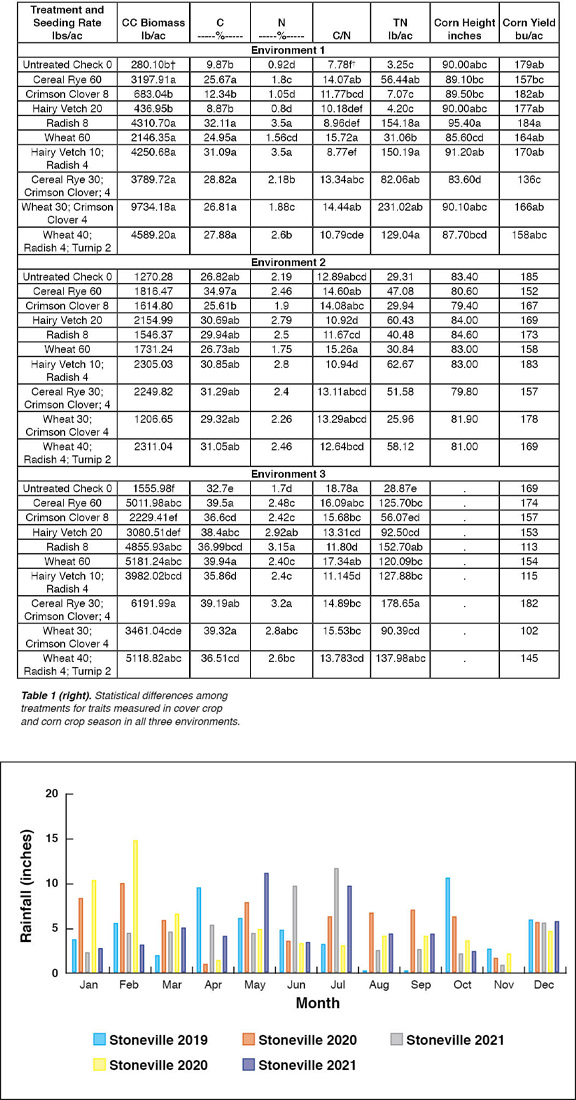Research Project
Can Winter Cover Crops Benefit Growth and Yield in Irrigated Continuous Corn?
Investigators: Bhupinder Singh, Gurbir Singh, Gurpreet Kaur, Jagmandeep Dhillon, Nicolas Quintana Ashwell
Date: 2021
Project Summary
Introduction
Farmers sometimes engage in continuous corn production when the market returns for corn rise. However, a risk of yield reduction is associated with continuous corn due to cooler and wetter soils, nitrogen (N) immobilization, increased disease risk, and allelopathy. Past studies have observed a yield reduction from 2 to 29% in continuous corn compared to corn following soybean. Nitrogen immobilization plays a dominant role in yield reduction in continuous corn among various factors. The substantial production of crop residue with high carbon-nitrogen (C/N) ratio in continuous corn has been a major cause of N immobilization. The corn residue in continuous corn decomposes slowly in winter due to low soil temperatures and low available N to soil microorganisms. Cover crops (CC) are proven to reduce leaching and deliver available N to the following cash crop. However, the impact of N cycling may vary with CC species, soil characteristics, and weather conditions. The overall objective of this study was to determine the benefit of CC to corn growth and grain yield in Mississippi.
Materials and Methods
Field experiments were conducted from 2019 to 2021 at three different sites in Mississippi including Stoneville (2019-2020), Starkville (2020- 2021), and Stoneville (2020-2021). The combinations of experimental site and year were referred to as environments, i.e., Environment 1 (Stoneville 2019- 2020), Environment 2 (Stoneville 2020- 2021), and Environment 3 (Starkville 2020-2021). The ten treatments consisting of a single CC or mix of CC species (brassica, grasses, and legumes) and a fallow treatment (check) were planted in the fall 2019 and 2020 at Stoneville and in fall 2020 at Starkville (Table 1). The corn hybrid DKC 70-27 (DEKALB®, Illinois, USA) was planted following CC termination in the spring 2020 and 2021 at all sites. Field management— such as tillage, weed, pest, fertilization, and termination of cover crops—was conducted following Mississippi State University Extension Service recommendations. Data collected includes CC aboveground biomass production, CC biomass %C, %N, C/N ratio, and total nitrogen uptake (TN), corn plant height, and corn grain yield.
Results and Discussion
The three single species CC were significantly different; grasses and brassica exhibited the highest biomass, grasses had the highest C/N, and legumes and brassica had high %N and TN. The mixture of two CC species balanced those traits for N scavenging and availability compared to single species. When planted as a single species or mixed with other CC species, radish enhanced corn plant height and corn grain yield of the following crop. Although a combination of cereal rye and crimson clover had higher %N than single species CC, there were no benefits to the following corn crop. The rainfall patterns were variable among environments and might have highly regulated CC N credits to the following corn crop based on traits measured in the study (Figure 1). For instance, high rainfall during CC season in Environment 1 might have resulted in lower N and TN in legumes (hairy vetch and crimson clover) with no difference from the untreated check. Legumes under low rainfall scenarios in Environment 3 had significantly higher N and TN than the untreated check. Although CC differed in C/N in all environments, only one of the three environments had treatments effects significant for corn plant height and corn grain yield. Cover crops belonging to different and even same species showed differential responses for traits measured among three environments. The information on species-specific functionality of CC in continuous corn under variable rainfall patterns suggests farmers consider a high diversity mixture of CC that outperformed among all three environments.
Project Photos

- Crop Type:
- Corn
- Topic:
- Cover Crops
Find Research
By Crop Type
By Topic
Contact NCAAR
General Information
Kaye Sullivan
vfs23@msstate.edu
662.390.8510
F:662.390.8501
Showcase Demo
Drew Gholson, Coordinator
drew.gholson@msstate.edu
662.390.8505
Himmy Lo
himmy.lo@msstate.edu
662.390.8509

